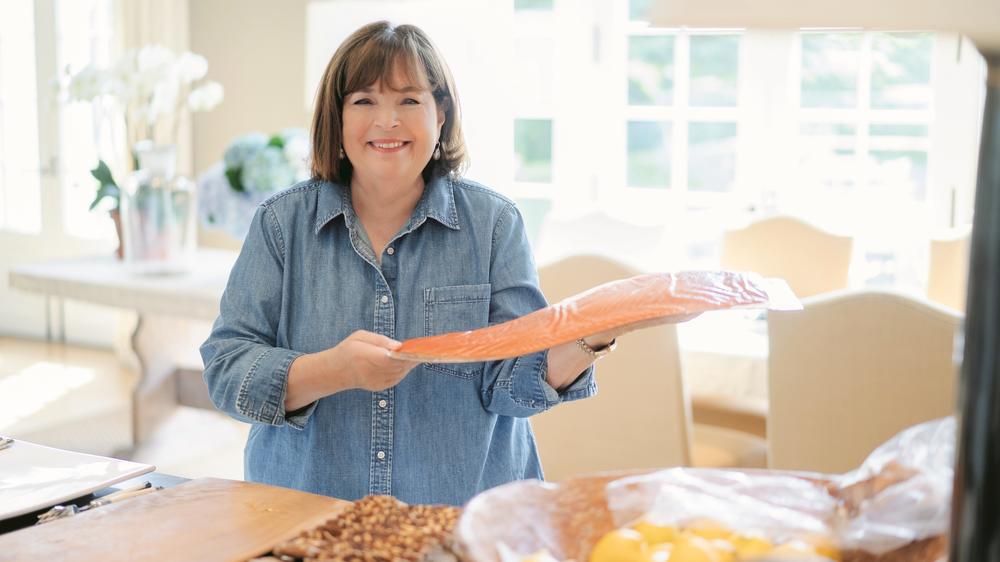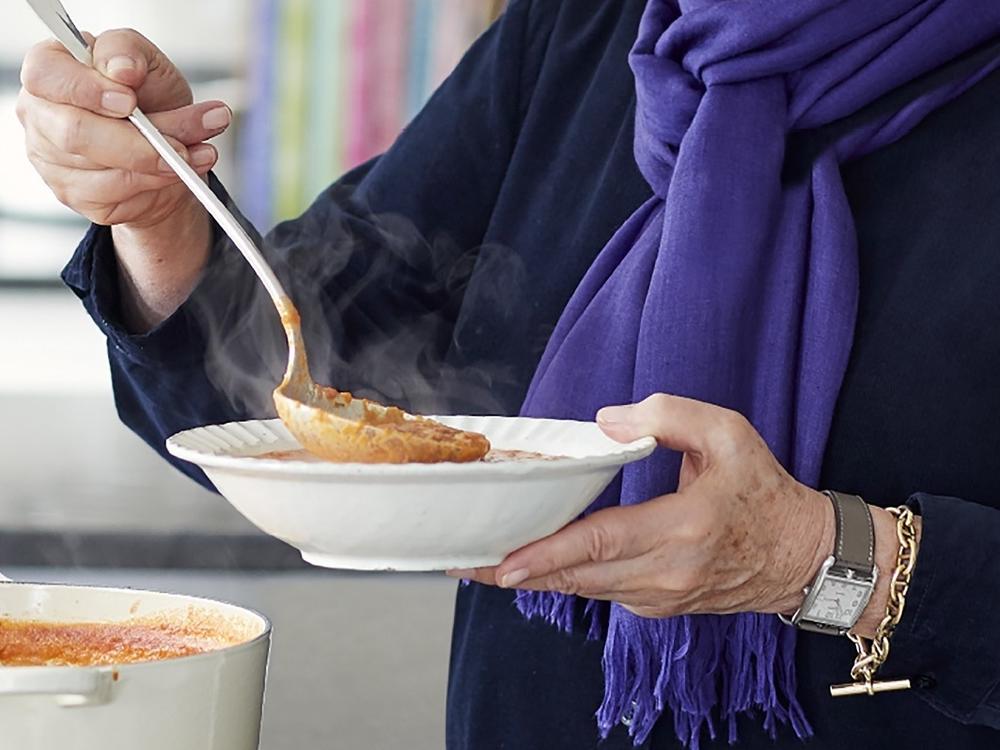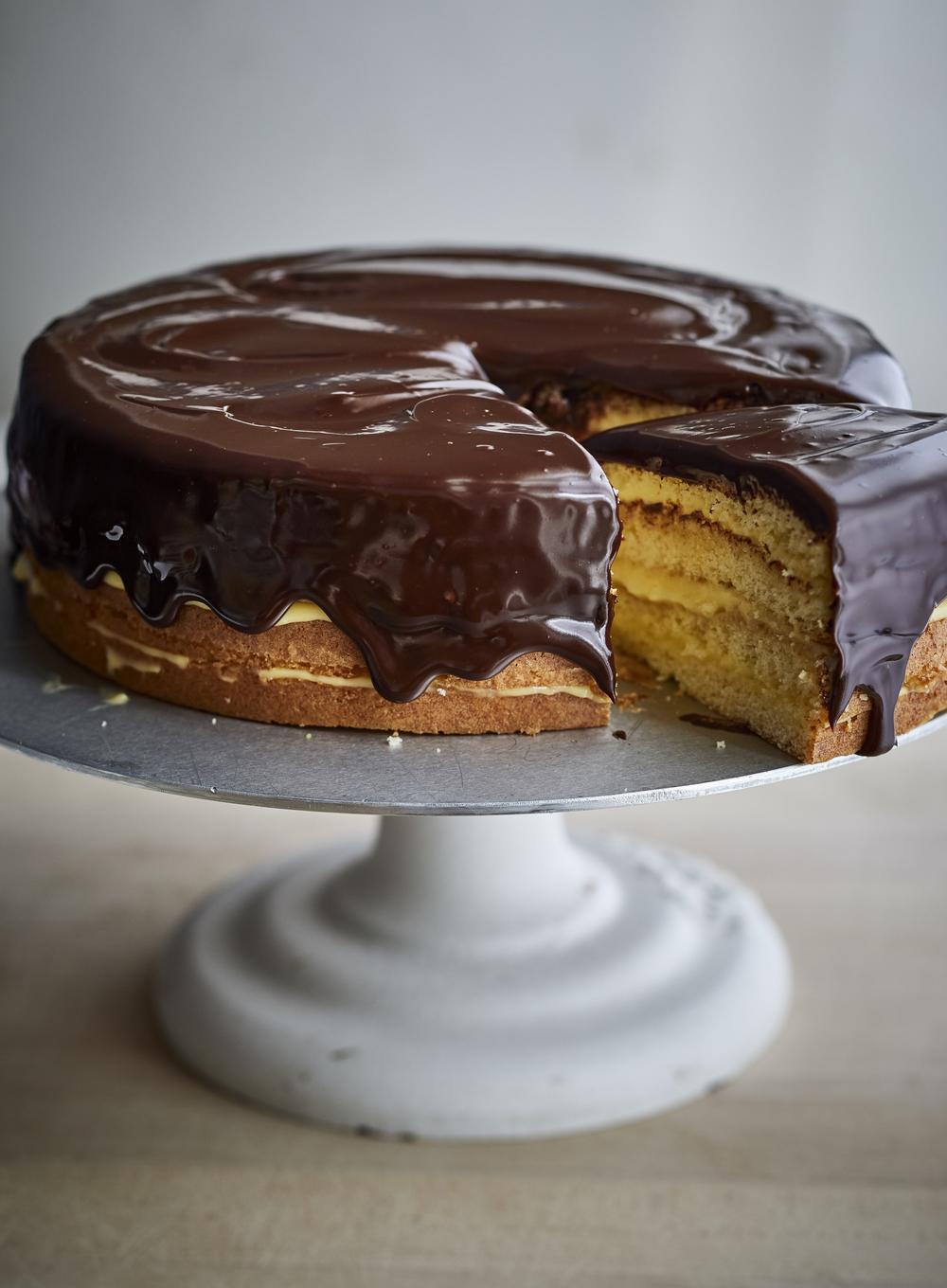Section Branding
Header Content
Ina Garten: 'All My Books Really Are About Comfort Food'
Primary Content
If you're feeling stressed out or overwhelmed by ... you know, everything ... this may be a good time to hear this very important message from chef and cookbook author Ina Garten:
"I often say that you can be miserable before eating a cookie and you can be miserable after eating a cookie, but you can never be miserable while you're eating a cookie."
That's Garten, reading the opening line from her new cookbook, Modern Comfort Food.
And yes, it includes a recipe for "giant crinkled chocolate chip cookies." But you'll also find soups, stews, breakfast tacos, cakes — the kinds of foods that are, in the author's words, "familiar, delicious, and soul satisfying."
Garten says that when she started writing, she knew the book was going to come out right before the election, and people would be stressed. "So I thought, why don't I do something about comfort food? But like with a modern twist, and that's how it started. Little did I know that there would be a horrible pandemic, world pandemic. There would be calls for racial justice. There would be the Supreme Court battle. There would be so many layers of stress that we couldn't even begin to imagine. And it's a terrible time for us, but in a nice way, I'm really happy that I was able to give people the tools to make something really comforting for themselves and their families."
Interview Highlights
On whether she changed anything in the book as the year went on
Literally nothing changed. I think I added one or two sentences to the intro, because it seemed delirious to put out a book that didn't acknowledge the pandemic. I mean, this is kind of where I live. I mean, all of my books really are about comfort food. There are times when you know, you feel like a really good salad, but not now.
This is the time that you need smashed eggs on toast, and beef stew that's been braised with red wine and cognac. You need things that are really satisfying. It's funny, this was like the easiest book I've ever written, but I sat down and thought about all of those flavors that we remember from childhood. And in each case I just said, OK, how can I make better tomato soup? So I did it with a little saffron and I did it with a splash of cream. So it was a little richer. And I did that with each thing, you know, every single one. I just took a remembered flavor that was familiar. And I just thought, how can I make it better? How can I make it easier to make?
On making things modern
Well, I take each thing and I really look at what can I do with it? Like pasta carbonara. It's like cream and bacon and cheese, and you want to take a nap afterwards. I mean, it's delicious, but it's really rich. And I thought, how can I lighten it? So I added all kinds of julienned spring vegetables and a little less cream. And it's just simple and it's delicious and it's got a freshness about it that classic pasta carbonara doesn't have ... Beef stew is usually pretty boring. The the meat is a little dry. And I thought, how can I make the meat better? And I thought instead of chuck, I would use short ribs which have so much flavor. When they stew for a long time, they flavor the sauce. They're delicious themselves. And then I borrowed two things from basically French beef stew, which is red wine and cognac. And so I ended up with a beef stew with classic potatoes and carrots and peas. But it's just got so much flavor and it's so much more satisfying.
On how people can still have holiday gatherings this year
Well, I think you definitely need to be conscious of social distancing. If it's a beautiful day and you can do it outside, you can certainly invite somebody and have a long table. And one group sits at one end and the other sits at the other end, and you can wrap yourself up with blankets and wear your winter coats — you know, we're so conscious of, oh, it's cold outside. We don't go outside. But in Europe, the French sit outside all winter. And I've certainly been known to sit outside and have dinner in my winter coat. It's perfectly fine. I think there's an expression it might be that Norwegians say there's no bad weather. It's only bad clothing. You know, bundle up, wear some hats and gloves and and have Thanksgiving dinner outside.
If you can get little heaters — I actually heard a wonderful story, very well-known interior designer put an electric strip underneath his table outside and gave everybody small electric blankets so that they could just plug into the strip. And I thought, that is so creative. I mean, just find some ways to keep yourself warm, because I'm not going to go through the winter and not see my friends. I'll curl up in a ball and die. We've been eating outside all summer. It's been heaven. You know, you're there under the stars. I've got a firebowl, I build a big fire in the firebowl and everybody feels like they've gone on a vacation. Maybe it's a great time to have a little Thanksgiving, just you and your family, the people who are quarantining with you and and forget about crazy Uncle George.
On what she'll serve friends when we can eat together again — hopefully, next summer
I'll say something fairly celebratory. I'll have lunch outside, lobster Cobb salad and a frozen Key lime pie. Or maybe this is the time to make the Boston cream pie that's in this book, which is just amazing. See, that's the kind of thing — what I did was. I took my idea of Boston cream pie, which is a vanilla cake with vanilla cream filling and and chocolate. I mean, it's OK. It's you know, it's vanilla and chocolate, but it's not really layered and interesting. And so I decided to infuse each of the layers with something that was either orange zest, Grand Marnier or cognac. And those things really added to the layers of chocolate and vanilla, orange and cognac. They just kind of made it really, really special.
Ina Garten's recipe for Boston cream pie
MAKES ONE 9 - INCH CAKE / SERVES 8
for the cake:
¾ cup whole milk
6 tablespoons (¾ stick) unsalted butter
1½ teaspoons pure vanilla extract
½ teaspoon grated orange zest
1½ cups all-purpose flour
1½ teaspoons baking powder
1½ teaspoons kosher salt
3 extra-large eggs, at room temperature
1½ cups sugar
for the soak:
¹⁄₃ cup freshly squeezed orange juice
¹⁄₃ cup sugar
1 tablespoon Grand Marnier
for the chocolate glaze:
¾ cup heavy cream
1¼ cups semisweet chocolate chips, such as Nestlé's (7½ ounces)
2 ounces bittersweet chocolate, such as Lindt, broken in pieces
2 tablespoons light corn syrup
1 teaspoon pure vanilla extract
½ teaspoon instant coffee granules, such as Nescafé
Grand Marnier Pastry Cream (recipe follows)
Preheat the oven to 325 degrees. Butter two 9-inch round baking pans, line them with parchment paper, butter and flour the pans, and tap out the excess flour. Set aside.
For the cake, scald the milk and butter in a small saucepan over medium heat (see note). Off the heat, add the vanilla and orange zest, cover the pan, and set aside. In a small bowl, sift together the flour, baking powder, and salt and set aside.
In the bowl of an electric mixer fitted with the paddle attachment, beat the eggs and sugar on medium-high speed for 4 minutes, until thick and light yellow and the mixture falls back on itself in a ribbon. By hand, first whisk in the warm milk mixture and then slowly whisk in the flour mixture. Don't overmix! Pour the batter evenly into the prepared pans. Bake for 22 to 25 minutes, until a toothpick comes out clean. Allow the cakes to cool in the pans for 15 minutes, then turn them out onto a baking rack, flipping them so the top sides are up. Cool to room temperature.
For the soak, combine the orange juice and sugar in a small (8-inch) sauté pan and heat until the sugar dissolves. Off the heat, add the Grand Marnier and set aside
For the chocolate glaze, combine the heavy cream, semisweet chocolate chips, bittersweet chocolate, corn syrup, vanilla, and coffee in a heatproof bowl set over a pot of simmering water. Stir occasionally with a wooden spoon, just until the chocolates melt. Remove from the heat and set aside for 25 to 30 minutes, stirring occasionally, until the chocolate is thick enough to fal back onto itself in a ribbon.
To assemble, cut both cakes in half horizontally. Place the bottom of one cake on a flat plate, cut side up. Brush it with a third of the soak. Spread a third of the Grand Marnier Pastry Cream on the cake. Place the top of the first cake on top, cut side down, and repeat with the soak and pastry cream. Place the bottom of the second cake on top, cut side up. Repeat with the soak and pastry cream. Place the top of the second cake on top, cut side down. Pour the ganache on the cake, allowing it to drip down the sides. Set aside for one hour, until the chocolate sets. Cut in wedges and serve.
Note:
To scald milk, heat it just below the boiling point— there will be small bubbles around the edge of the milk. Don't let it boil!
Don't refrigerate the assembled cake because beads of condensation will form on the chocolate.
To make ahead:
Prepare the cakes and pastry cream, wrap well, and refrigerate separately. Prepare the chocolate glaze and assemble an hour before serving.
Grand Marnier Pastry Cream
MAKES ENOUGH FOR ONE 9-INCH CAKE
5 extra-large egg yolks, at room temperature
¾ cup sugar
¼ cup cornstarch
1½ cups whole milk
1 tablespoon unsalted butter
1 tablespoon heavy cream
1 tablespoon Grand Marnier
1 teaspoon Cognac or brandy
½ teaspoon pure vanilla extract
Beat the egg yolks and sugar in the bowl of an electric mixer fitted with the paddle attachment on medium-high speed for 4 minutes, until very thick. Reduce the speed to low and add the cornstarch.
Meanwhile, scald the milk in a medium saucepan. With the mixer on low, slowly pour the hot milk into the egg mixture. Pour the mixture back into the saucepan and cook over medium-low heat for 5 to 7 minutes, stirring constantly with a wooden spoon, until the mixture starts to thicken. When the custard starts to clump on the bottom of the pan, stir constantly with a whisk (don't beat it!) to keep the custard smooth.
Cook over low heat until the custard is very thick like pudding. If you lift some custard with the whisk, it should fall back onto itself in a ribbon. Off the heat, stir in the butter, heavy cream, Grand Marnier, Cognac, and vanilla. Whisk until smooth and transfer to a bowl. Cool for 15 minutes. Place plastic wrap directly on the custard (not the bowl) and refrigerate until very cold.
This story was produced for radio by Will Jarvis and William Troop, and adapted for the Web by Petra Mayer
Copyright 2020 NPR. To see more, visit https://www.npr.org.



